Allen Tiller's Blog, page 23
December 16, 2019
Sunshine Café Murders
Sunshine Café Murders139 Gouger Street
In 1944, at the age of 20, John Balaban was sitting in his bedroom in Romania. He had just finished reading another of many philosophical books, a hobby he took up after his abusive and habitually drunk father had suicided by hanging himself. On this morning, John concluded, after all that he had read and been through, that there was no God. At that very point, Johns bedroom ceiling opened as if lifted from above, and a bright cloudy light lit the room.
God, in the image of a man with long white hair and a grey beard smiled down on John and said unto him;
“John, it is alright if you don’t believe in me anymore. You do anything your conscience dictates and you will be happy.”
After Gods visit, which Balaban stated ‘was not a dream’, Balaban thought he could do anything, as he was no longer afraid of the law.
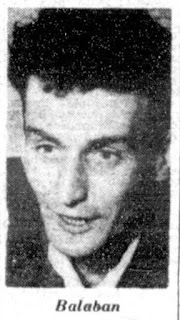 John Balaban:
John Balaban:Source: 'BALABAN TO HANG', The News, (29 July 1953)
In 1946, only two years later, Balaban who was prone to violent rages, was admitted to a mental health facility in Romania.
In 1947 Balaban committed murder in Paris when he strangled to death Hungarian national, Reva Kwas.
Balaban moved to Australia in 1951.
In 1952, he killed prostitute Zora Dusic in her Torrensville shack by first strangling her, then cutting her throat with a knife he found on the dressing table. In 1952, Balaban married Thelma Cadd, and went to live with her, Thelma’s young son, Philip from a previous relationship and Thelma’s mother, Mrs Ackland, at the family business, The Sunshine Café on the corner of Gouger and Morphett Streets in Adelaide. John and Thelma got along for a while, but the relationship soon became unstable, and John claimed he was tired of Thelma’s constant complaints, about, in his words “everything!”
On that fateful day, April 11th, Balaban began drinking and found himself near the River Torrens parklands. At some point, he had a fight with a woman in the female toilets of the parklands, and when stumbling around outside, found a large iron bar. He made his way along the Torrens and sat down with a man and woman and had a few drinks with them, before assaulting them both with the iron bar, and walking away.
Later, he was chased near the Torrens Tennis Courts by an unknown man, then turned upon his assailant with the iron bar, and beat him senseless. After his rampage, Balaban returned to the Sunshine Café. He believed everyone was against him and decided he would kill his wife as she, in his mind, was the reason he had become angry and gone out fighting and assaulting people.
Balaban began his murderous spree by hitting his wife on the head with a claw hammer, beating her to death. He then thought he might kill Mrs Ackland in the same manner, and afterwards Phillip. In his deposition to the courts he stated; "Phillip sat up and cried, and I hit him, I thought it better that he dies too than live under a shadow.” In his cold-blooded killing spree, Balaban then went out to the sleepout where Verna Manie (a café employee) slept, and killed her too.In a chilling statement, Balaban, during his court trial, went on to say; "I only killed those at the Sunshine Cafe because they deserved to be killed."
John Balaban was hung in the Old Adelaide Gaol on the 26th of August 1953. The ghost of the notorious homicidal maniac, John Balaban, is alleged to have been seen in the old Adelaide Gaols “Hanging Tower’, and was identified by a witness after seeing a photo of Balaban in the front foyer, and identifying the man she had seen sitting on a bench inside the tower.
Published on December 16, 2019 14:53
December 10, 2019
A Ghost at the Jens Hotel Mount Gambier
A Ghost at the Jens Hotel Mount GambierIn a recent blog post (found here: http://hauntedadelaide.blogspot.com/2019/09/the-haunted-jens-hotel-mount-gambier.html) I described the alleged haunting of the Jens Hotel at Mount Gambier.
Among the many spirits said to haunt the hotel is the spirit of female child. She is believed to be around 4 years old and is alleged to haunt the ground floor. It is believed she is waiting for her mother to return.
This photo was sent to me by a former worker at the Jens Hotel who claims that the image in the picture closely resembles that of a 3-year-old child, the daughter of a former publican, who died in the hotel.What do you believe, ghost or not?

Published on December 10, 2019 01:00
December 3, 2019
Allen Tiller’s Top 5 Most Haunted Hotels in South Australia
Allen Tiller’s Top 5 Most Haunted Hotels in South Australia
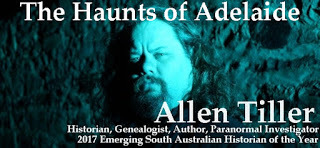
I have never done one of these on the blog before, but thought it time. The following hotels, in my opinion, are the (allegedly) most haunted in South Australia. You are welcome to disagree with me, or submit your own opinion on which South Australian hotels you would put in your top five, in the comments here or over on facebook at:
SA Paranormal: https://www.facebook.com/SAParanormal/Eidolon Paranormal: https://www.facebook.com/EidolonParanormal/Allen Tiller (Official): https://www.facebook.com/AllenHauntingAustralia/The Haunts of Adelaide: https://www.facebook.com/TheHauntsOfAdelaide/
1. North Kapunda Hotel
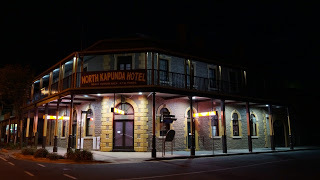
Licensed as “The North Kapunda Arms” in 1849, this pub grew from the growth of the copper mines in Kapunda and would later be the home of Sir Sidney Kidman’s horse sale, the largest ever held in the world. Long considered the most haunted pub in the most haunted town in Australia, The North Kapunda Hotel is home to a plethora of phantoms thought to be ex-residents, publicans, ladies of the night, and miners – the activity in the hotel was recently documented on Haunting: Australia, including a “possession” of one cast member!
Previously it had featured on the documentary “Kapunda: Most Haunted Town in the Western World”.
North Kapunda Hotel: http://hauntedadelaide.blogspot.com/2019/05/ghosts-of-barossa-north-kapunda-hotel.html
Hallway From Hell: http://hauntedadelaide.blogspot.com/2016/06/kapunda-hallway-to-hell.html
2. Overland Corner Hotel
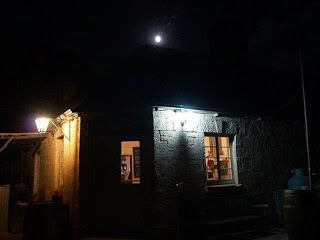
The Overland Corner Hotel is situated on the bend of the Murray River between Renmark and Barmera. It is an isolated pub that has seen two of Australia's most iconic Bushrangers drink at its bar. Many active spirits have been reported as haunting the pub for the past 160+ years of its existence. Some of the ghosts are thought to be the Brand brothers, the original family builders of the hotel, who lived, laughed played and died within the Iconic Hotels walls.Other spirits include that of a local aboriginal girl, and even Queen Adelaide!
Devlin’s Ghost: http://hauntedadelaide.blogspot.com/2013/06/devlins-ghost.html
EVPs captured at the Overland Corner Hotel by Eidolon Paranormal: https://www.youtube.com/watch?v=_WSkkE8P2qw
3. Grand Millicent Hotel
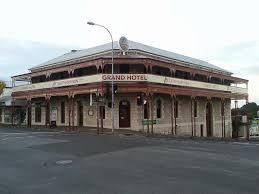
A recent TV advertisement has listed The Grand Hotel at Millicent as the 2nd most haunted pub in South Australia, but as you can see, in my opinion, it comes third.
It is thought the hotel is haunted by up to 10 different ghosts which includes the spirit of a little boy who is seen playing near a pool table. The ghost of an elderly man who is seen ascending the staircase, and a spirit who leaves wet handprints on the walls!
ABC News report on the haunting and investigation: https://www.abc.net.au/news/2017-07-31/hunting-the-ghosts-of-the-grand-hotel/8752610
4. Copper Coast Hotel
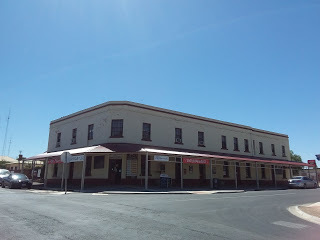
I have investigated the hotel on several occasions, both privately and with the public, and have encountered some very strange phenome within its walls.
The upstairs section of the hotel houses the guest’s suites and shared shower facilities. This seems to be the epicentre of the haunting, particularly in the one wing containing bedrooms 11 through to 13.
On one occasion, about the middle of the day, I was standing in the junction of the hallways, which wind and turn through the upper levels. In one spot I could smell very distinctly the smell of the ocean and old tobacco, but take a step in any direction and the smell would be completely gone. Now, not being one to jump to the “ghost” conclusion in an instant, I put it down to being so close to the ocean, and the smell of tobacco being embedded in the walls and carpets, and didn’t think any more of it, until I went downstairs to the dining room and a psychic told me that right above us was a spirit of an old Swedish sailor who had died elsewhere, but returned here as he felt this was home – (this still did not convince me the place is haunted by a Swedish sailor!).
EVP captured at the Copper Coast Hotel (formerly The Cornucopia Hotel): https://www.youtube.com/watch?v=-VkNioLcM5w
Cornucopia Hotel – MEGAscene: https://issuu.com/risingstarmedia/docs/megascene_issue_7
5. Golden Fleece Hotel – Gawler
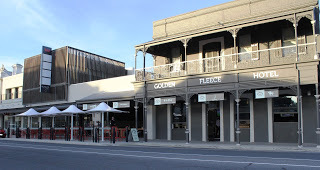
Gawler's oldest hotel, The Golden Fleece Hotel first opened its doors on April 1st 1840. The hotel is famous for its hauntings, with one exceptional ghost photo being taken by photographer Scott Pearson in the mid-1990s The hotel is reputed to be haunted by a little boy who sometimes seen sitting on the front bar. Other ghosts include an old gentleman and teenage girl. The rear of the hotel was once the town's morgue, until a proper morgue was built by local funeral firm Taylor and Forgie’s.
Scott Pearson’s Ghost Photo: http://strangenationaustralia.blogspot.com/2012/09/ghosts-of-old-spot.html Ghosts of Gawler: https://hauntedadelaide.blogspot.com/2013/02/the-old-spot-hotel-ghosts-of-gawler.html Spring-Heeled Stephen: https://hauntedadelaide.blogspot.com/2013/01/spring-heeled-stephen-ghosts-of.html
Published on December 03, 2019 00:03
November 26, 2019
Paranormal Research: National Library of Australia’s TROVE (Part 3) - Referencing on Trove
Paranormal Research: National Library of Australia’s TROVE (Part 3)Referencing on Trove

Prior posts on this topic:Paranormal Research: The Manning Index of South AustraliaParanormal Research: National Library of Australia’s TROVE (Part 1) – Basic Search
Paranormal Research: National Library of Australia’s TROVE (Part 2) - Advanced Search
It is essential that researchers and writer in the paranormal field reference their work. Not only does this stop criticism from potential sceptics, as you can show where ideas and events are sourced from, it also stops plagiarism. Plagiarism is already rife in the field, and the more we stop it, the less infighting we will have.
Another valid point, that I am very vocal about on social media, is referencing our writing, showing our legitimate sources lends credence and respect to the field. It shows those in the scientific and research fields that we are serious about finding the truth about whatever it is we are researching. That we are more than just pseudoscience.
So whether you are planning on writing a book or blog about ghosts, it is essential that you reference the materials you use in your research. It proves what you are talking about was reported widely. It proves you are not making the story up yourself, but it also proves you are not stealing the original work, word for word, or even worse, changing the story to fit your own narrative, as so many tour groups in this field are guilty of doing.
Referencing is a standard convention within the academic and professional research communities, which is designed to inform the reader of the sources of information used in a piece of written work.There are several referencing systems in common use, with certain systems being preferred in different academic disciplines., my preferred styles are Chicago and Australian Harvard. I tend to lean more toward Chicago style now, and use extensive footnoting. (which we will get to in another blog post)
There are two parts to every referencing system (or footnoting):
1. The “in-text reference”; a reference to a source of information placed within the body of the work.In text Referencing Example: “Doyle write about looking for a Skeleton on Rundle Street. (The Register, 1921).”
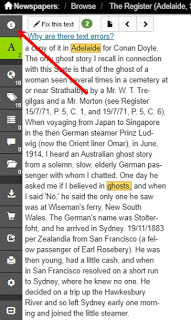 2. The “reference list”; a list of all sources referred to in the work, located at the end of the work. (A slight variation is the Bibliography).
2. The “reference list”; a list of all sources referred to in the work, located at the end of the work. (A slight variation is the Bibliography).Luckily for us, Trove makes things a simple for referencing. If we search a newspaper story on Trove. You will find on the left-hand side are several symbols. The first is an information symbol, this is where Trove cites the work for you. Most of the time the 3rd citation down is Harvard.
So, you can copy and paste, or write it down as is, and add it in your Reference List/Bibliography or in-text referencing:
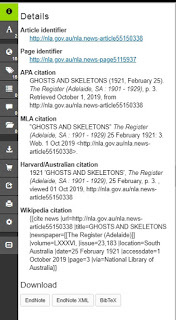 (Harvard Example)
(Harvard Example)‘1921 'GHOSTS AND SKELETONS', The Register (Adelaide, SA : 1901 - 1929), 25 February, p. 3. , viewed 05 May 2017, http://nla.gov.au/nla.news-article55150338
Because of the layout of Blogger, I cannot add the content of this talk in its entirety in one blog post. This transcript was originally presented as an interactive video presentation at the City Library in Adelaide and does not transcribe well to this format.
© 2017 - Allen Tiller - originally presented by Allen Tiller as part of the 'Haunted Buildings in Adelaide' - Paranormal historian in residence project at the Adelaide City Libraries in conjunction with the City of Adelaide.
Published on November 26, 2019 01:00
November 19, 2019
Paranormal Research: National Library of Australia’s TROVE (Part 2) - Advanced Search
Paranormal Research: National Library of Australia’s TROVE (Part 1)"Advanced Search"Prior post on this topic:Manning Index of South AustraliaTrove Part 1
Head to Trove at this location: https://trove.nla.gov.au/newspaper/search?adv=y
Now, just under the search window is a couple of checkboxes, which let us search Australian content only or through library holdings, but let's go to the last option though, 'Advanced Search'.
This search window allows us to search in another way that can be much more helpful than basic newspaper search.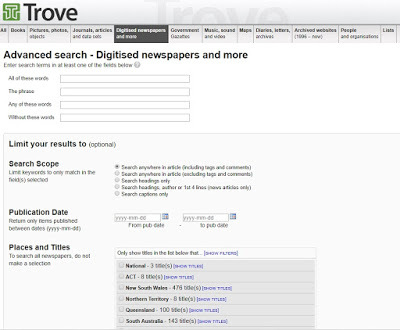
In the top search box: “All of these words” window, lets type in “Adelaide Arcade” in inverted commas.
In the box “Any of these Words” window lets type in 'Murder, Suicide, death, crime' – then hit search

Trove has now searched every newspaper in its catalogue for the term 'Adelaide Arcade', and the terms we used. As you will see in your results, there is now a ton of deaths, crimes and suicides to look through for this one location – including the death of Sydney Byron Kennedy and a number of others.For the murder of Florence Horton, which happened at the Rundle Mall end of The Adelaide Arcade, we would change our search to “Rundle Street” instead of "Adelaide Arcade" in inverted commas, as her death, and subsequent haunting of the Arcade were reported as a crime on the street rather than in the Arcade.
Let’s just jump back to our Advanced search window, in the top search "All of these words" write “Adelaide” in inverted commas, in the “Any of these words” section type; 'ghosts, paranormal.' Now in our “Without these words” window we will type; 'theatre, movie'. then press "search"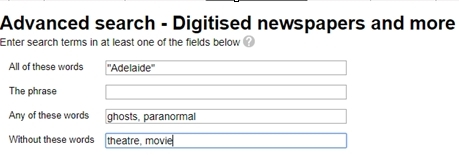
We’ll refine a little more by selecting South Australia from our “place” limiter and now we have a ton of reports of ghosts, and UFO’s from South Australia.
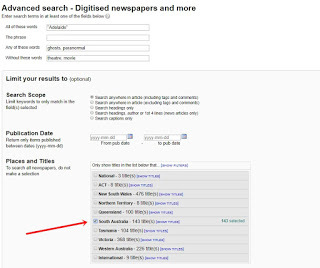
If we scroll down to number 8 “Ghosts and Skeletons” you will see one of the stories I used, as a jump-off point for more research for my book The Haunts of Adelaide, which involves Sir Arthur Conan Doyle looking for a photo of a skeleton displayed in Rundle Street Adelaide.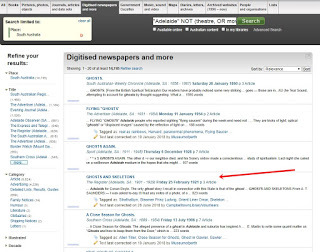
As you can see we get a lot of newspaper stories, some are about published poems, but many are local ghost sightings.
Next Week: How to Reference your book, blog or writing using Trove.
Because of the layout of Blogger, I cannot add the content of this talk in its entirety in one blog post. This transcript was originally presented as an interactive video presentation at the City Library in Adelaide and does not transcribe well to this format. Next week I will look at Advanced searching options on Trove.
© 2017 - Allen Tiller - originally presented by Allen Tiller as part of the 'Haunted Buildings in Adelaide' - Paranormal historian in residence project at the Adelaide City Libraries in conjunction with the City of Adelaide.
Head to Trove at this location: https://trove.nla.gov.au/newspaper/search?adv=y
Now, just under the search window is a couple of checkboxes, which let us search Australian content only or through library holdings, but let's go to the last option though, 'Advanced Search'.

This search window allows us to search in another way that can be much more helpful than basic newspaper search.

In the top search box: “All of these words” window, lets type in “Adelaide Arcade” in inverted commas.
In the box “Any of these Words” window lets type in 'Murder, Suicide, death, crime' – then hit search

Trove has now searched every newspaper in its catalogue for the term 'Adelaide Arcade', and the terms we used. As you will see in your results, there is now a ton of deaths, crimes and suicides to look through for this one location – including the death of Sydney Byron Kennedy and a number of others.For the murder of Florence Horton, which happened at the Rundle Mall end of The Adelaide Arcade, we would change our search to “Rundle Street” instead of "Adelaide Arcade" in inverted commas, as her death, and subsequent haunting of the Arcade were reported as a crime on the street rather than in the Arcade.
Let’s just jump back to our Advanced search window, in the top search "All of these words" write “Adelaide” in inverted commas, in the “Any of these words” section type; 'ghosts, paranormal.' Now in our “Without these words” window we will type; 'theatre, movie'. then press "search"

We’ll refine a little more by selecting South Australia from our “place” limiter and now we have a ton of reports of ghosts, and UFO’s from South Australia.

If we scroll down to number 8 “Ghosts and Skeletons” you will see one of the stories I used, as a jump-off point for more research for my book The Haunts of Adelaide, which involves Sir Arthur Conan Doyle looking for a photo of a skeleton displayed in Rundle Street Adelaide.

As you can see we get a lot of newspaper stories, some are about published poems, but many are local ghost sightings.
Next Week: How to Reference your book, blog or writing using Trove.
Because of the layout of Blogger, I cannot add the content of this talk in its entirety in one blog post. This transcript was originally presented as an interactive video presentation at the City Library in Adelaide and does not transcribe well to this format. Next week I will look at Advanced searching options on Trove.
© 2017 - Allen Tiller - originally presented by Allen Tiller as part of the 'Haunted Buildings in Adelaide' - Paranormal historian in residence project at the Adelaide City Libraries in conjunction with the City of Adelaide.
Published on November 19, 2019 01:00
November 16, 2019
Gawler Gas Works - Hidden Secrets
Gawler Gas Works10 Seventh Street, Gawler.
[Begin Transcript] In 1868, The Provincial Gas Company was formed to be direct competition to the South Australian Gas Company. The company’s foundation members included local Gawler businesses men James Martin and Sir Walter Duffield. The Provincial Gas Company planned to build three gas works, one in Strathalbyn, one in Kapunda and one in Gawler. Parliament granted incorporation of the company in 1869, with equipment ordered from England the same year.
The Gawler Gas Works were built on 7th street, Gawler. Its fires were lit on the 10th of September 1869 with gas commencing through lines from the 14th of October 1869. Gawler Council did not wish to outlay money towards lamp lights within the town. It took until 1879, with the donation of a lamp for the northern end of Murray Street, from the aptly named H.E. Bright Junior for Gawler to get its first lamp. The next lamp was situated at the corner of Murray Street and Calton Road, and again was a donation, this time from James Martin. G.M. Hawkes donated a lamp for the southern intersection of Murray Street and Bridge Street.
A man was employed in Gawler to light and extinguish the lamps. He rode a bicycle with a ladder on his shoulder. Gawler Council refused to light the gas lamps for 6 nights before, and six nights after a full moon. It also demanded all lamps to be extinguished from 10:30 pm to save money.From 1866 until 1897 Gawler’s lamplighter was Mr Creyghton. Creyghton was replaced in 1897 after a lamp exploded, and he could not explain to the council how it occurred. Mr Coward started as lamplight in 1898 earning 2 pounds, two shillings and 6d per month for his service. Coward served as a lamplighter in Gawler until 1909. The combined position of Nightman and Lamplighter was advertised in Gawler that same year.
The new lamplighter D Wells faced considerable opposition from Council and was accused of not doing his job properly, with many councillors wanting the position refilled. Councillor Thorrup opposed stating that, the new lamplighter had not received much training from the previous man employed and needed more time to improve. Wells quit the position in March 1910.
Gawler South appointed its own lamplighter from 1907, Mr Michael Regan. In 1908 the position went to H. Masters.Electricity generation came to Gawler on the 16th of June 1912. Mayor Reibech flicked the switch to turn on the new electric streetlights at the official opening on the 16th of August 1912.The Gawler Gas Works continued production, supplying gas in the region, but with the installation of electricity in the town, the demand for gas dropped. The outbreak of World War One added further problems to the gasworks, making the supply of machinery and coal from NSW harder to come by. The Gawler Gas Works officially closed on 30th of November 1917.
After many years of being empty, the site of the former gas works became a racing stable, with a house home built on the property as well. The house was demolished in 2017.
In 2018 the site has been made available for sale, with real estate agents, McGees property stating on their website about the site:Approval for a modern, single-storey medical centre of 543 square metres (approx.), 51 car parks and a separate administration building of 390 sqm (approx.)
The rear former gasworks is protected under heritage laws, and can be modified for adaptive use, but must be preserved in future plans. [end transcript].
Researched, written, compiled, filmed and edited by Allen Tiller. [© 2019 – Hidden Secrets]
My thank to McGees Property: https://www.adl.mcgees.com.au/Find out more about the sale here: https://www.adl.mcgees.com.au/buying/commercial-listings.php?sid=758667&suid=3e3cfc28967fd35712c6761ffe1f9f6e
Gawler History Team: www.gawlerhistory.comGawler Gas Works: https://gawlerhistory.com/Gawler_Gas_WorksMayor Rebbeck: https://gawlerhistory.com/Rebbeck_Charles_George
Published on November 16, 2019 22:29
November 13, 2019
Shades of Black - Book
Shades of Black

A collection of poetry, prose and short stories written by award-winning historian and paranormal investigator Allen Tiller over three decades. This collection includes many previously unpublished original works written by Allen in his early twenties.
Buy Shades of Black here:Amazon EbookAmazon BooksBook Depository. Booktopia
Published on November 13, 2019 23:12
The Haunts of Adelaide - Book
The Haunts of Adelaide - Book
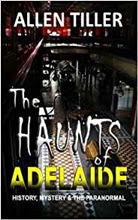
Published by CUSTOM BOOK Publications It has always been Allen Tiller's aim to provide factual insight into haunted locations in Adelaide, and indeed, the rest of Australia. He lifts the veil on ghost stories and reveals the truth behind the myths and tales that so often become an urban legend and local folklore. His mission is to research the historical facts of locations, people, places and buildings - from a distinctly paranormal perspective. The Haunts of Adelaide was born...Buy The Haunts of Adelaide - CLICK HERE
Published on November 13, 2019 23:08
November 11, 2019
Paranormal Research: National Library of Australia’s TROVE (Part 1) - Basic Search
Paranormal Research: National Library of Australia’s TROVE (Part 1) - Basic Search

www.trove.nla.gov.au
Prior Posts related to this Blog:
Paranormal Research: The Manning Index of South Australian History
Trove is one of the biggest public databases in Australia, it contains more than 370 million resources, spread across ten content zones which includes: Books, Photos, Journals, Newspapers, Government Gazettes, Music, Maps, Diaries and Letters, Archived Websites, People, and Lists.
The focus here is on content in digitised newspapers. (Trove also supplies a specific section with information about searching newspapers.)
1. In this exercise, we are going to enter the term "Death of the Arcade Beadle" in inverted commas into the search bar. And hit enter, we can see our entry from the Manning index in slot two (see prior blog post The Manning Index <click here> )…

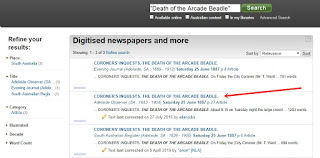
now let’s find it without the inverted commas. As you can see in the example below, we now have a ton of related content spread across all States and various newspapers. What we want to do now is to refine our search
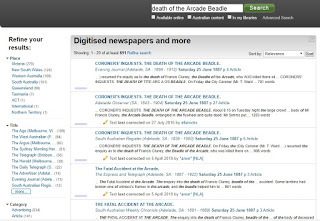
 Example 12. The easiest way to refine our search: we know that the newspaper we are looking for is from South Australia, so in the first left-hand side drop-down menu we choose South Australia – we then skip the newspapers and go straight to category – we know it’s an article, so we click that option. (see example 1)
Example 12. The easiest way to refine our search: we know that the newspaper we are looking for is from South Australia, so in the first left-hand side drop-down menu we choose South Australia – we then skip the newspapers and go straight to category – we know it’s an article, so we click that option. (see example 1)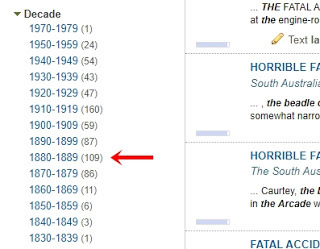 Example 23. Next, we click "Decade" and scroll down to 1880-1890, which gives us 29 options of newspaper to read through, all from 1887. Our particular newspaper is second on the list, so we can click it and read it if we like. (example 2)
Example 23. Next, we click "Decade" and scroll down to 1880-1890, which gives us 29 options of newspaper to read through, all from 1887. Our particular newspaper is second on the list, so we can click it and read it if we like. (example 2)From here, we can do many things, we can look through the various newspapers, most of which are the same, we could open up our search to the whole nation, which is sometimes useful because you will find that the newspapers in the state where an accident or crime happens will sanitise their stories so as not to offend the family, so an interstate newspaper may have a more in-depth story about the death or crime you are researching.
Because of the layout of Blogger, I cannot add the content of this talk in its entirety in one blog post. This transcript was originally presented as an interactive video presentation at the City Library in Adelaide and does not transcribe well to this format. Next week I will look at Advanced searching options on Trove.
© 2017 - Allen Tiller - originally presented by Allen Tiller as part of the 'Haunted Buildings in Adelaide' - Paranormal historian in residence project at the Adelaide City Libraries in conjunction with the City of Adelaide.
Published on November 11, 2019 15:55
November 5, 2019
Paranormal Research: The Manning Index of South Australian History
Paranormal Research:The Manning Index of South Australian History

http://www.slsa.sa.gov.au/manning/
What is the Manning Index?
The Manning Index is a database of South Australian history, owned by the State Library of South Australia. The Manning Index is an index of Adelaide newspapers from 1837 through to 1937, together with extracts from the published works of G.H. Manning, and essays written from 1982-2002.
It also contains a list of place names in South Australia.The index is incredibly useful to paranormal researchers as it allows us to find significant information about crimes or deaths or facts about a location. It gives us the newspaper, the date, and the page of the newspaper so we can then go to the National Library of Australia’s, “Trove” newspapers section < https://trove.nla.gov.au/newspaper/?q= > to cross reference our research or find the article in its entirety.
The index also overlaps with the State Library Of South Australia’s catalogue to some extent, and features many of the newspapers available in the State Library, such as: Adelaide Times, The Advertiser, The Chronicle, The Critic, Express & Telegraph, Frearson's Weekly, The Herald, Illustrated Adelaide Post, The Irish Harp, The Lantern, The Mail, The News, Observer, Register, SA Gazette & Mining Journal and the Southern Australian.
The index is divided into four folders, which can be found in the top left-hand corner of your screen, these folders are:South Australia: includes coverage of a number of 'State level' topics.Adelaide: includes a number of topics which predominately relate to the city and the metropolitan area as a whole.Port Adelaide: includes references to Port Adelaide.Place Names of South Australia: an alphabetical list of South Australian place names (including suburbs of Adelaide).
Each folder contains several sub-folders, which themselves may contain more subfolders.Some subjects are indexed extensively in more than one section. Generally, biographical references can be found on pages dealing with the place or activity a person is associated with. A few place-names also contain obituaries of people associated with the place name.
ALL place names are inverted, so 'Mount Gambier' will be found as 'Gambier, Mount'.
There are two ways to use the Manning Index:
You have the option to search via the “Searching folder”, which allows you to search the State Library Catalogue and the Manning Index. If you click on the yellow folder, you will see both options. If you click on the Manning Index subfolder, you will see it takes us to a Google search engine. If you write Adelaide Arcade in the provided search engine, and press search, you will see that it brings up everything with the words “Adelaide” and “Arcade”.To make your search more specific we can add inverted commas to the search; “Adelaide Arcade”. We now get three results. If you look to the right-hand side of the screen you will see a drop-down menu that says “sort by” which allows us to look at our findings via relevance or date.
The second way to use the Manning index, assumes you know a little something about your topic already. We know that the Adelaide Arcade is in Adelaide, and is a building. Go to the yellow ‘Adelaide’Folder and click it. Scroll down the list and find the subfolder, “Buildings”and click on it. Next, we see a list of buildings, written in blue.
The Adelaide Arcade stands by itself, whereas other buildings are grouped into types. If we click the Adelaide Arcade hyperlink, we are giving a small list of pages where the Arcade is mentioned in local newspapers.We can make note of these newspapers as a starting point for our next searchable index, the National Library of Australia’s Trove. So you can either write them down, highlight them with your mouse and copy and paste them into a Word File, or screen capture them for later reference:
Adelaide ArcadeSketches of the Adelaide Arcade are in the Pictorial Australian in
August 1885 (supplement),
January 1886, page 12.
Also see Register,
30 April 1885, page 6g,
1, 14 and 15 December 1885, pages 7a, 4h-5b-6e and 6g,
Express,
7 May 1885, page 4a,
12 and 14 December 1885, pages 3f and 3g,
17 December 1895, page 4c.
"Death of the Arcade Beadle" is in the Observer,
25 June 1887, page 27a.
For more info on Geoffery Manning < Click Here>
for a photo of Geoffery Manning: <Click Here>
Researched and written by Allen Tiller ©2017, for the 'Haunted Buildings in Adelaide' research project at the City of Adelaide Libraries.
Published on November 05, 2019 01:00



